"Birth and death; we all move between these two unknowns." -Bryant H. McGill
One of the most remarkable consequences of the Big Bang is that the Universe as we know it -- full of planets, stars, galaxies and life -- hasn't been around forever! Because the Universe is expanding and cooling, it was hotter, denser, and more compact in the past.
But these things that fill the Universe today weren't there in the very early stages of the Universe; they took time.
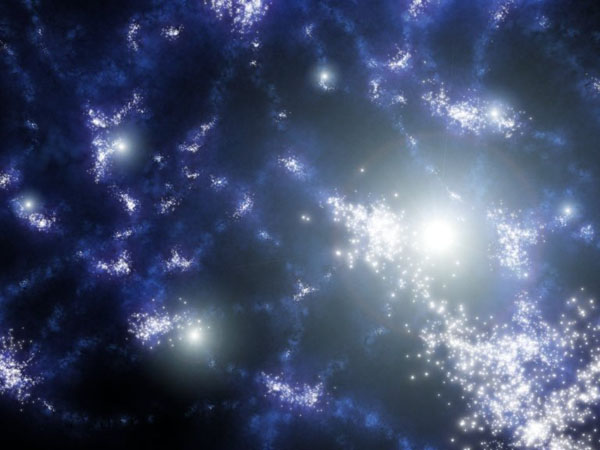
Gravity needed many millions of years to collapse these slightly overdense regions to a point where even the first stars could be formed, much less galaxies and clusters of galaxies. Well, if you're curious, you might ask this question about black holes: was the Universe born with them, or did they, too, need to wait for millions of years for gravity to do its thing?
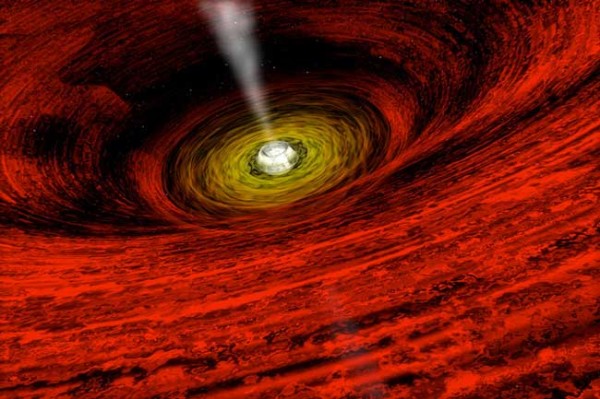
Some of the most remarkable things that our Universe contains are black holes, which come in two known varieties. On the one hand, there are the kind that are around the mass of our Sun, that come from the deaths of massive stars.
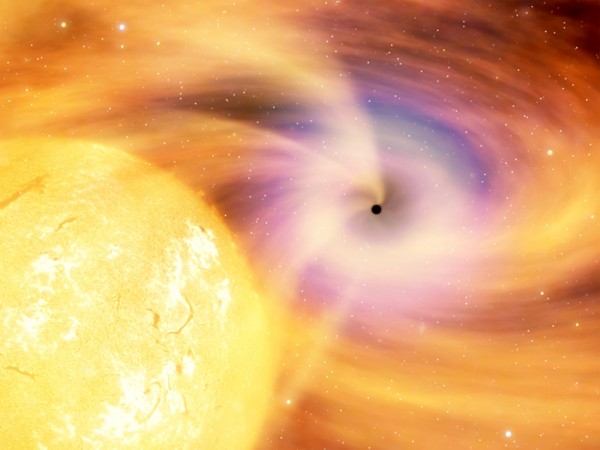
And of course, these guys took at least as long to make as it took to form the massive stars. We have a huge number of black hole candidates in our own galaxy, shown in red -- superimposed over our galaxy's stars -- in the image below.
But there are also much more massive black holes. These range from black holes thousands of times the mass of our Sun (in purple, above) to the supermassive ones (in blue) found at the centers of galaxies. The supermassive ones, in fact, can be millions of times the mass of our Sun -- like in our own galaxy -- up to several billion times that mass, like in the galaxy M87. Regardless of size or activity level, every large galaxy we know of has a supermassive black hole at its center.
These two types are generally accepted by the scientific community, but there is another type that occasionally gets some attention as well: miniature black holes! Smaller in mass than single stars but larger than about the mass of a mountain (otherwise they would have evaporated by now), these rogue black holes could be strewn throughout the Universe, including our galaxy, and are sometimes speculated to be a significant fraction of dark matter.
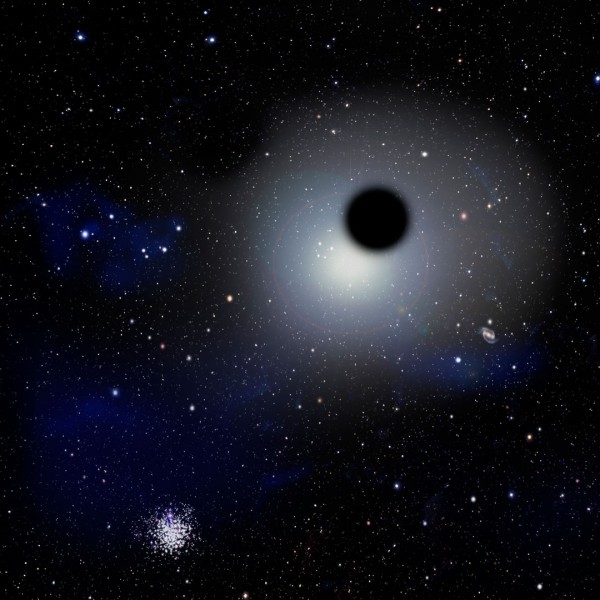
This idea was interesting when it was developed in the 1970s and 1980s, but we know a whole lot more about the Universe now than we did then. Let's ask what we need to form these black holes back when the Universe was first born, and see if we can determine how much validity there is to such an idea.

If you want to gravitationally collapse the matter in any region of space -- which you need to do if you want to make anything, including a black hole -- it needs to have a great enough energy density to overcome the expansion of the Universe. According to our understanding of structure formation, runaway collapse -- what specialists call non-linear structure formation -- happens once your energy density in one region of space becomes about 60% greater than average.
So if you want your Universe to be born with black holes, you need some small regions of space to be born with about 60% more energy than average. Let's take a look at the Universe and see what it's doing when it's very young.
This image shows the fluctuations, or the departure from average temperature, in the leftover glow from the Big Bang. The average temperature -- as we see it today -- is 2.725 Kelvin. So, you'd reason, if you had warm regions where the temperature was somewhere around 4 Kelvin, and the cool regions were somewhere around 1 Kelvin, you would form these black holes in very short order after the Big Bang.
This wouldn't happen on large (i.e., degree-sized) scales, though; they would have to have these fluctuations on much smaller scales. Let's take a look at how these fluctuations, from when the Universe is 380,000 years old (when the leftover glow from the Big Bang is emitted), change with scale.
As you can see, these fluctuations are nowhere close to being of Kelvin scale; we're talking tens to hundreds of microKelvins, at most. What's even worse is if you remember that we need to have larger magnitude temperature fluctuations on smaller scales to get these micro-black-holes.
And as both a simple visual inspection and a detailed analysis of the scalar spectral index show, the initial fluctuations are not larger on smaller scales.
So while it might be fun to speculate about small, primordial black holes, to the best of our knowledge they are not part of our actual, physical Universe.
Much like Vince Lombardi once said about leaders, the same is true of black holes, that they
aren't born, they are made. And they are made just like anything else, through hard work. And that's the price we'll have to pay to achieve that goal, or any goal.
Gravity will do that work for you, in the end. But you have to give it enough time to do its job. In the beginning? The fluctuations are simply too small. But given millions of years, they'll grow, collapse, form stars, and then you'll get your black holes.
Massive, very massive, and supermassive black holes should all exist. But the tiny ones?
Not in our Universe.

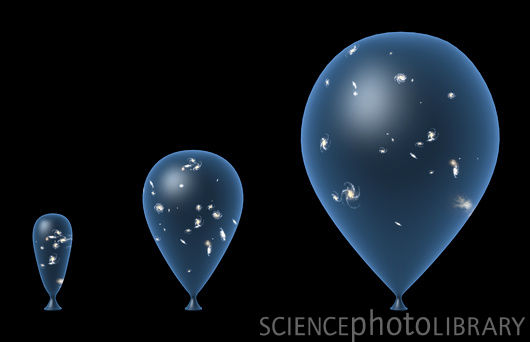
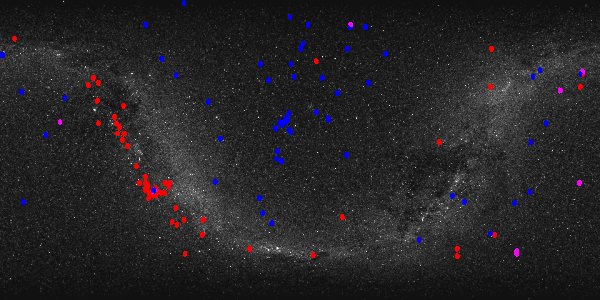
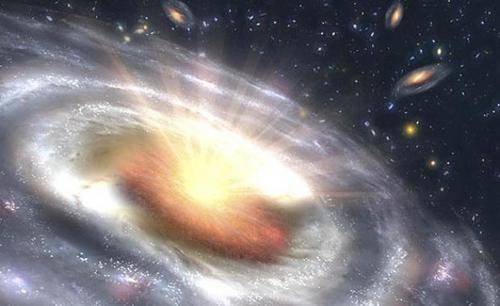

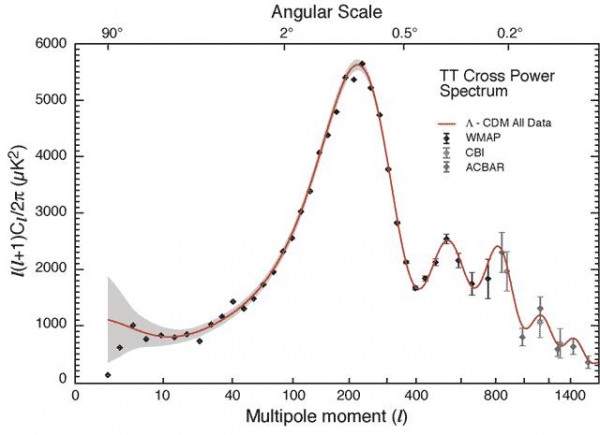

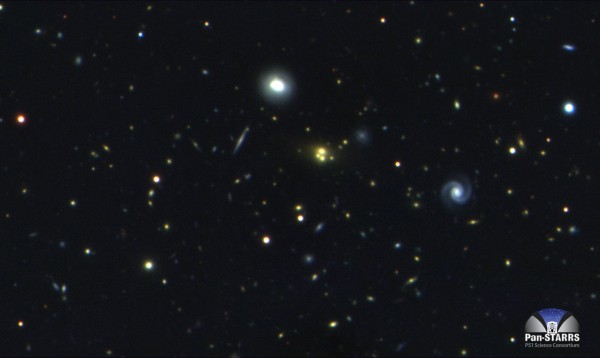
Could you explain, as if for a novice, exactly what is being presented in the WMAP graph? For instance, from the description in this post, it sounds like the curve describes the variation in average temperature fluctuations of the cosmic microwave background. But the upper x axis is labled in degrees (which is degrees of arc across the sky, right?) while the lower x axis is labeled "multipolar moment" and I don't know what that is. Also, what's the formula on the y axis? What are those variables? I ask because I've been looking at this graph for years, having it presented by any number of cosmologists and physicists, but I've never really understood exactly what its showing (or, as I would usually put it, how to read it). You're really good at explaining things, so I'm hoping you'll consent to explain this. Thanks.
I think you prove too much.
You have proved that routine creation of Big Bang Black holes is inconsistent with observation, but not that zero were created in the big bang. It is conceivable that there are even smaller areas with wide fluctuations.
Thank you! Lovely clear as usual.
--o--
Two irrelevant questions sparked by a troll recently:
1) If the CMB is the surface of last scattering when radiation decoupled from matter, shouldn't its energy when released fit the ionisation energy of Hydrogen, 13.6 eV? Or at least the lowest excitation level of H? But according to the wikitubes it was only 0.25 eV.
2) Supposedly a fractal structure of the Universe could do away with Dark Energy, but I frankly can't follow the argument.
I assume he means Dark Energy as some sorta substance, rather than just the phenomenon of accelerated expansion (which I thought was standard), but he's not really clear. Nor about Dark Matter (mass 30 times that of Hydrogen? - what does that mean?).
The 'dangerous idea' is from 2006, just before the Bullet Cluster, so ideas may well have been different back then.
But almost more importantly, is there any evidence that the distribution of matter is fractal? I've heard the idea, but what would be the mechanism for producing self-similarity? Assuming of course such a think is to be found.
Sorry to go so far off topic.
Love the Lombardi quote. Especially since we get a FULL SEASON OF FOOTBALL!!! Thank you Santa. I wont ask for anything else this year.
Another good post. I recall hearing Pamela Gay also say that it was highly unlikely for bholes to be born at the beginning of the universe. (One of)Her take(s) was that it was not reasonable to conclude that huge gas clouds would form perfectly into a black hole. She said most likely the gas cloud would have small density variations that would cause it to collapse into several stars, as opposed to collapsing neatly into one large black hole. And once the first few stars kicked on the solar wind would make things even more variable and possible less likely to get a black hole out of the deal.
isn't there a possibility that one of the larger black holes, perhaps from the lower end of the scale, could evaporate faster than it consumes for a time and fall into the smaller category?
Wazza, I think for a stellar mass to evaporate down to a mountain's mass via Hawking radiation would require much longer than the elapsed age of the universe.
If my physics profs in university had used pictures like these in lectures, maybe I'd have stayed on a science & engineering track instead of switching to music. (I jest to some extent.)
Fantastic illustrations to a nifty post on a cool topic!
I feel I must put up at least a token defense of primordial black holes (PBHs), if only because theorists brighter than myself still continue to write papers on them.
Although, MobiusKlein has already succinctly made my first point -- that larger fluctuations on much smaller scales than can be probed by the CMB are not ruled out. And they do pop up in some models of inflation.
Of course, even given their creation, it's entirely possible all of them will have evaporated away, leaving little trace that they ever existed (there would be a Cheshire Cat Grin-like presence of a stochastic gravitational wave background that could be detected).
They are stunning images with which illustrate this article, on the other side so interesting and intriguing as the universe itself.
Since nobody has tackled Rich's question @1 yet, I'll try.
It is often convenient to look at scale sizes of variations in various domains. If your system can be described as a time series or a box, you would expand it in a Fourier series. When you are looking at a sphere, as here, you expand in a set of functions called spherical harmonics. Spherical harmonics are described by two indices (much as a Fourier expansion would have one index per dimension of your box): l, which describes the largest oscillations you might encounter if you go around the sphere in some plane, and m, which describes how many oscillations you would encounter if you go around the sphere in the equatorial plane (inversely proportional to the angular size of the fluctuation). The allowed values of l are non-negative integers (your function has to be single valued), and m must be an integer ranging from -l to l (ditto). The Y axis units are what they are because a power spectrum of some quantity will be the square of that quantity's units divided by the units of your oscillation (which for spherical harmonics is dimensionless), thus the units of a power spectrum of temperature as a function of fluctuation size will be [temperature]^2. The factor l(l+1) pops up in the differential equation which describes spherical harmonics. That factor and the 2π are some kind of conventional normalization; as this is not my field I cannot explain why that convention was chosen.
@8 (Jim) I'm not just contemplating ones beyond the current limits, but also fluctuations that are unobservable. Consider the CBMW that has already passed us by, or has not yet reached us. But yes, the observations show it's not routine to have PBH.
A question about the microwave data - is there any possible process that would smooth out the variations after the original emissions?
I'm not convinced of this argument.
Nor am I expecting to find primordial black holes.
My problem is the WMAP/NASA map has already been greatly modified (as I understand it). For example, all of the data for stars has been removed. And other things have been removed. All reasonable assumptions in building a WMAP map.
But in doing that polishing of the data, much detail has been lost. This is OK for most purposes of the data; but if I want to use this WMAP map to make any conclusion regarding the density of matter to form any early universe very large star or a black hole or a planet the size of Jupiter; I believe all of that kind of detail has already been scrubbed out of the WMAP/NASA map.
Tell me I'm wrong; and explain why. But I followed the links once to NASA site and they did a lot of scrubbing to get their final map.
crd2 @4, once you get non-linear collapse of sufficiently large masses, you should eventually create black holes. The electromagnetic forces of atoms -- assuming you have neutral atoms -- does an excellent job of resisting collapse beyond a certain point. It is unclear that Moon-mass objects, for example can overcome that.
Wazza @5 and Artor @6, a black hole created in the early Universe of mass < 10^12 kg would be gone by now. But a black hole of more than about 10^14 kg would be virtually unaffected by Hawking Radiation in terms of mass loss. Compared that to the Earth (~6 x 10^24 kg) or the Sun (~2 x 10^30 kg), and evaporation effects would take somewhere around 10^70 years to be important.
MobiusKlein @2 and Jim @8, of course there are ways to contrive inflation to give you a spectral index that runs sufficiently at the low end (unobservable by WMAP and Planck) to give you as many PBHs as you want. The only way to rule that out is to do an exhaustive search. However, a typical inflation model (like a power-law scalar field) gives you fluctuations that change with scale by hundredths of a percent, as opposed to the tens-of-thousands of percent change you would need. I agree that it hasn't been completely ruled out experimentally, but I would contend that whatever theoretical motivations once existed for PBHs no longer exist.
OKThen @12, people are right to worry about the "mask" used for WMAP. However, that mostly affects the large-angular-scales, or the low multipoles. We have enough "sky" to look at that the mask doesn't affect the very small angular scales. Still, we are talking about scales well beyond what WMAP can probe, and so, as I said to Jim and MobiusKlein, the only way to be sure is to do the exhaustive search. But I am comfortable working within the theory/paradigm we have and drawing the conclusions I drew above.
Ethan
Thanks for the explanations 4, 5, 6, 2, 8, 12. But one further question: Can you shed some light on the difference between primitive black holes and primordial?
http://www.jpl.nasa.gov/news/news.cfm?release=2010-088&cid=release_2010…
March 17, 2010 NASAâs Spitzer Unearths Primitive Black Holes
" scientists believe the very early universe didn't have any dust -- which tells them that the most primitive quasars should also be dust-free... Spitzer has identified two -- the smallest on record -- about 13 billion light-years away from Earth... The black holes at the cores of J0005-0006 and J0303-0019 have the smallest measured masses known in the early universe, indicating they are particularly young, and at a stage when dust has not yet formed around them." "Each quasar is anchored by a supermassive black hole weighing more than 100 million suns. " Wow, doesn't seem small to me; certainly not a mini.
In several web articles, NASA's term "primitive black holes" has been replaced with the term "primordial black holes"; your perspective would be appreciated.
i don't know whether I'm right or wrong but............i believe that a black hole easily formed in our laboratories....
if my calculations are correct than by causing a nuclear explosion in a highly shielded laboratory.....it may end up in a black hole....and may be just may be we can test whether the black holes are a destructive type or like a transporter.....................!!!!!!!
i meant that 'black holes can easily be formed in out laboratories'
Was the universe born with black holes? Black holes are dense, but not as dense as when all the matter in the universe was compacted into one solid mass. Comparatively, solid matter is like ice where as black holes are more like water. Let us examine the big bang theory, which should be a theory of everything but is far from it. First, there is a big explosion, which explains nothing in terms of what we know and see in the universe. Certainly our universe filled with galaxies was no direct result of an explosion. Second, the resultant radiation now expanding at an accelerated pace has no direct relation to how the universe is today. Third, the radiation by what science claims it 'somehow seems to have' condensed into atoms and photons is short on scientific proof.
Radiation condensing into photons and atoms in an expanding/accelerating universe? What twisted folly. Nothing within this theory explains the obvious characteristics of galaxies, namely that they are thin, spinning and spiral shaped. It also fails to explain the nature of solar systems, especially or own. What does the big bang theory explain? It explains nothing about which we know and see yet is now considered fact. Referring an explosion to God's great moment of creation mocks Him.
SMBH's are what I call Liquid light. They are fragments of a larger core that was even more condensed. So much more condensed that the 'liquid light' state of a black hole was now solid. Frozen light. SMBH's spin very fast and they shed matter from time to time. When it does, it is such a violent process that many of the photons escaping are transformed into atoms, as well neutrinos and various forms of radiation. Naturally, since the black Holes are spinning, the shedding occurres at the equator of the Black hole. That is why galaxies are thin and exist at the equatorial position of the black hole. Conversely, as the matter that comes out of the black holes transforms into stars, the stars often shed matter at the equator and that matter become planets. That is why the planets of a star are found along the equatorial plane of the host star. Here, everything is explained. Where do planets come from, stars, black holes and galaxies. With this, there is never a reworking of ideas. Band aids like Dark matter are unnecessary. This theory fits and explains what we see and know. On the other hand, the big bang theory is contradictory to what we know and see. The idea that an exploding core resulting in pure radiation condenses in an expanding universe is absurd. Our universe is growing, and the flower which are galaxies began as a pod of highly condensed matter we refer to as black holes. The black holes themselves were once a single unit of absolutely solid matter, and were created by being chipped away by tremendous 'lightning' type strikes upon the original matter core. As the matter core began to dissolve, a plasma field developed and when it reached a certain temperature, electric discharges slammed into the matter core chipping off pieces. Like a magnet that is broken, the small chips flew away from the matter core, spinning and being further attacked by electric discharges as it passed through the plasma field. As the chips emerge from the plasma field, they are now budding galaxies. If the chip is not dissolved enough by the time it escapes the plasma field, a quasar will result. That is the true nature and origin of the universe. Galactic matter does not go into black holes, it is where galactic matter comes from. Once matter leaves the black hole, and is converted into atoms, they cannot return to the black hole. The black hole is spinning too fast for matter to reenter. Experimental proof is clear. A spinning object, like a water soaked sponge, sheds matter at the equator. We must discover the one true fundamental particle of the universe. They make up everything, including light, and the known forces. To say black holes 'feed' is at best funny. To suggest creation is a condensing and forming process within a universe that is expanding is ridiculous. With no mechanism, how can radiation begin to form in to atoms? With dark matter? How convenient to have something that does not exist be the explanation for a failed theory like the big bang. The big bang theory was based upon the assumption that the universe was decelerating. Should that not raise a few eye brows in question? As long as man searches for the answer to where we came from with the big bang theory as the foundation for the search, it will fail just as it has and will continue to do. Finally, the discovery of a black hole consuming a star is only a theory based on certain events. I suggest that the bright blasts are from matter coming out of the black hole, not the reverse. At this time we cannot say for sure which is correct.
Dear Folks,Some time ago, I proposed that since time is the moveemnt of the mind, then the fact that there is also an objective time indicates that we must be living in the mind of a colossal entity. It is the moveemnt of this time that we are observing, one that is independent of our subjective mind and time. So there are two times: one internal and subjective and the other objective.It appears that this may be true from the observations in the pictures below. If so, what is this mind? If you study Dianetics, this mind is not very intelligent. So god is not very intelligent. It only has creative powers and its creations create all life that we see in the universe. We co-create with this universal mind, so to speak. We are both one, like the yin and the yang. Alexandra David-Neel, a French journalist, was able to create a living being by mental concentration for 6 months (Magic and Mystery in Tibet, 1929).In 1950, Ron Hubbard wrote a book called Dianetics in which he revealed astonishing scientific discoveries of the Mind. He explained that man has 3 minds: the analytical, the reactive and the somatic minds. As it is too long to explain everything here, I will be brief. Whilst the analytical mind is like a computer and needs to rest and be protected, the reactive or unconscious mind is awake all the time. It is actually a rather stupid mind, concerned only with emotional and physical pain. It is driven by engrams (programs?) fed to it even before birth. These impinge on the analytical mind, like computer viruses, slowing it down considerably. By removing the engrams, a person becomes Clear ( similar to Enlightenment) when his mind functions at 100% capacity, rather than the 5 10% capacity he now operates at. A friend of mine, an engineer from South Africa, confided he attained the Clear about a year ago. He wrote cryptically about a time 70 trillion years ago and other things which I need to clarify from him once we meet. He started me on Dianetics.The interesting thing is that the Four Noble Truths expounded by the Buddha all relate to suffering or pain. Actually the Four Noble Truths can be reduced to one and that is pain. This leads to the interesting question: Did the Buddha analyse the Reactive Mind? He also proposed a way out of this pain in the Four Noble Truths. We can remove engrams from the reactive mind. My friend promised to explain many things to me when I meet him, which I hope will be soon.So there you are. God may not be as bright as you think he is. It is a creative force which we drive.Happy thoughts.
"then the fact that there is also an objective time indicates that we must be living in the mind of a colossal entity"
Objective time indicates no such thing. It only indicates that we can independently show time passes. As in independently of the agreement of other people.
Just like we can objectively show a solid floor doesn't allow passage of other solid objects.
But that doesn't indicate a greater mind that maintains that.
Jet,, i dont know how you surmised this information and i find some of it interesting.However you could be as wrong as the next man.I have a theory that the Universe is speeding up simply because energy speeds up when there is no mass to slow it down,this will continue for eternity,unless a different factor changes it. The Big bang would suggest that a slow down would occur initially without this consideration
got the relation b/w GOD, ENERGY , AND BLACK HOLES...
(black holes/zero)= infinite energy=GOD..